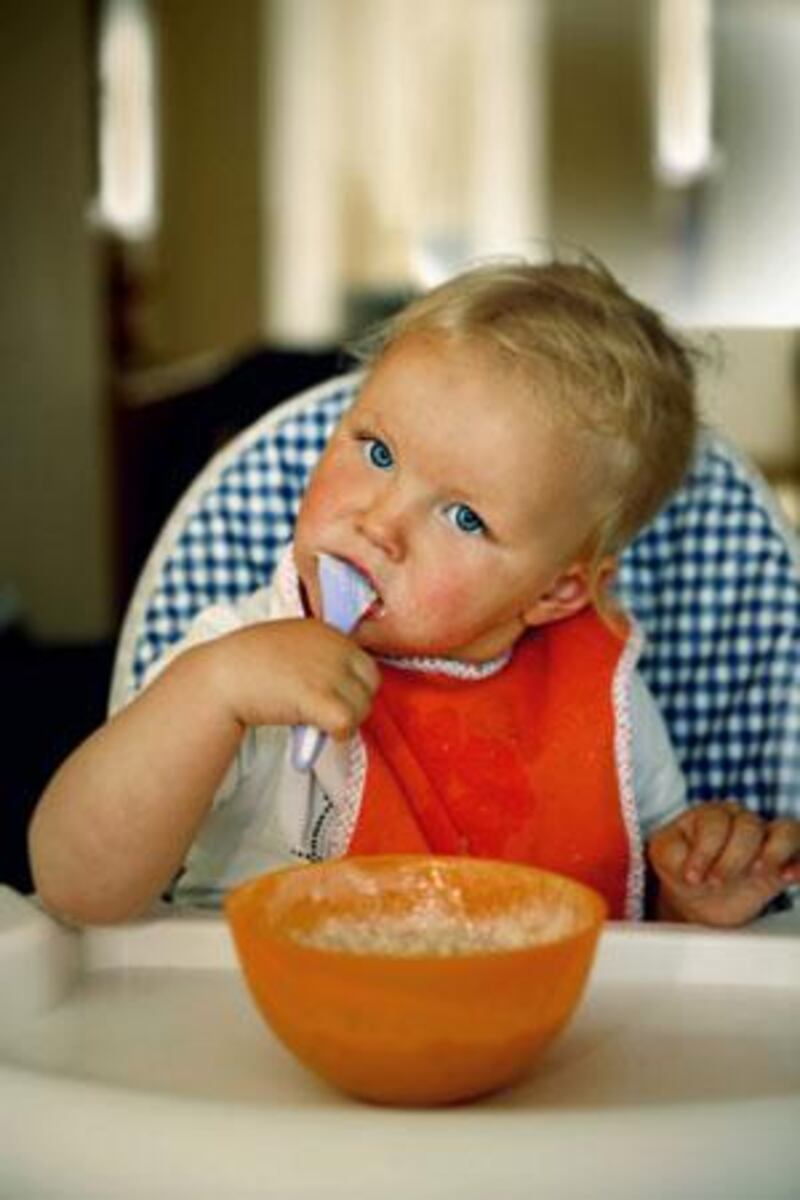Mealtimes used to be so clean. At six months old, Astrid sat in her high chair with her mouth wide open and gaping like a freshly hatched gosling. She was poised and waiting for each lick of the spoon. She wasted little and rarely spilt any on the floor. She usually ate the entire bowlful. Her tastes were wide ranging and unfussy. Cleaning up afterwards involved lightly dabbing stray morsels from the corners of her mouth with a damp cloth. All in all, mealtimes used to be pristine affairs.
How times have changed. During a typical meal now, debris is scattered far and wide. Astrid flings dollops of matter across the room. She uses her spoon as a catapult. She flicks bits so they stick on the wall. Food can reach a radius of up to two metres around her high chair. She paws her fodder with her hands and squeezes it through her fingers. She drops it down her front, so by the end of the meal her lap has become as full of food as her bowl was at the beginning.
We bought her a special bib to protect her clothes during these messy, thrice-daily sessions. It resembles a radiation suit or some other protective gear because it is long-sleeved, shiny and bright green trimmed with blue. Even with this garment on, Astrid somehow manages to cover her clothes in bits of banana and bread. It is as if mealtimes and getting dressed have blended into a single event: Astrid has decided she will wear food from now on.
Don't get me wrong; I'm not complaining about the transformation of eating into a grubby riot. It is all part of Astrid's burgeoning independence. She wants to have some say over what goes into her mouth and how it happens. Most of the time she wants to feed herself, which involves grabbing the spoon close to the food end, putting it in her mouth, turning it over and scraping it off with her lower teeth. That's if the manoeuvre goes well, which it rarely does. And so the chaos begins.
Hand in hand with the mess has come a new finickiness about food. I read somewhere that perhaps the reason children develop such fussy eating habits is that they have so little control in the rest of their lives. They hold no sway over where they go, what they do or when they go to sleep, but they can decide what they eat. Mealtimes become an arena for power struggles, a place where rejecting food garners more attention than eating it.
Astrid's likes and dislikes change from day to day. Perhaps she is already inculcated into the tyranny of choice that dominates 21st century life. Already I find myself asking her if she would like apple or pear or some other such meaningless decision. Obviously without words, her response is difficult to decipher. Even with words, much of the time her choice would, I imagine, be arbitrary. Keeping her lips pressed tightly shut and shaking her head is less an expression of dislike of a particular taste and more a way of asserting her character in a more potent way than elsewhere.
Our palates are formed early. The structure of our likes and dislikes, the map of our tastes that will determine how we eat for the rest of our lives, is set in the first few years. A lifelong hatred of sprouts, for example, might have stemmed from a bad mood when you were two years old. The answer must be to keep mealtimes as jolly and simple as possible.
Astrid has developed an attachment to an interesting and unusual object. It is a bit of wood from the top of a set of wooden rings. The rings are different sizes and colours. They stack together on a pole to form a rainbow of brilliant colours. In contrast, the top is dull and plain, the colour of polished pine. Yet Astrid loves it. What is the appeal of this wooden talisman? How can it prevail over other, more ostentatious, battery-powered toys? I can only speculate. It is chunky and tactile. It is rounded at one end and sharper at the other. It is just the right size for her to grip. It has holes, which she puts her fingers in. Undoubtedly she finds it easy to hold, but she must also get comfort simply from keeping it in her hand. There is satisfaction in clasping such a smooth and solid thing. No doubt it is the first in many prized items from which Astrid will be inseparable - for at least a week or two.





